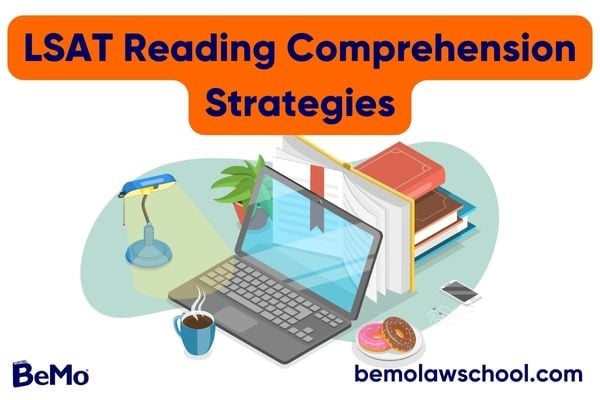LSAT reading comprehension strategies are an essential tool for acing the test, one of the common law school requirements. While it may seem more straightforward than the rest of the test, it can be deceptively tricky. In this article, I’ll cover my top LSAT reading comprehension strategies and how I used them to ace my LSAT!
>>Want us to help you get accepted? Schedule a free initial consultation here <<
LSAT Reading Comprehension Strategies: Why are They Important?
Why is it important to implement LSAT reading comprehension strategies in your LSAT study schedule and on the real test? As I began preparing for the LSAT, I soon realized that mastering the Reading Comprehension section was crucial for achieving my desired LSAT score.
The LSAT Reading Comprehension section involves detailed passages from various disciplines, requiring not only understanding but also the ability to analyze and evaluate complex information within a limited timeframe. Initially, I found myself struggling to navigate through these detailed texts and retain essential information. Through commitment and careful planning, I enhanced my skills to work through this challenging section of the exam.
Recognizing my weaknesses was the first step towards improvement. Through conducting an LSAT diagnostic test, I recognized two key areas that I was struggling with: slow reading speed and ineffective comprehension strategies, such as passive reading. Without addressing these weaknesses of mine, success on the LSAT seemed less attainable.
While the LSAT reading comprehension section might seem like the “easiest” of the LSAT sections, this doesn’t mean you shouldn’t have solid strategies on how to approach this section—and ace it. More than earning an impressive score for your law school application, this section of the test teaches you foundational skills you NEED as a future law student.
Before we dive into the reading comprehension strategies, we’ll break down the LSAT reading comprehension section so you know what to expect.
LSAT Reading Comprehension Section Breakdown
If you’re not familiar with what is on the LSAT, the Reading Comprehension section is made up of a selection of high-level reading materials followed by several multiple-choice questions.
There are 4 text passages on the reading comprehension section—3 standalone text passages and 1 pair of passages that are connected. Each text passage is followed by 5-8 multiple-choice questions about the content of the passages.
What type of questions are on the LSAT reading comprehension section?
The questions on the LSAT reading comprehension section may ask about any of the following characteristics of the passages, according to the LSAC, which administers the test:
- MAIN IDEA OF THE PASSAGE
- INFORMATION EXPLICITLY STATED IN THE TEXT
- IDEAS INFERRED FROM THE PASSAGE’S CONTENT
- MEANING OR PURPOSE OF PHRASES OR WORDS USED IN THE PASSAGE
- ORGANIZATION AND STRUCTURE OF THE PASSAGE
- APPLYING INFORMATION IN PASSAGE TO A NEW CONTEXT
- IDENTIFYING THE PRINCIPLES AT WORK IN THE PASSAGE
- ANALOGIES OF THE PASSAGE’S ARGUMENTS OR EVIDENCE
- AUTHOR’S ATTITUDE OR TONE TOWARD A TOPIC
- HOW NEW INFORMATION WOULD IMPACT THE PASSAGE
The questions following the pair of passages will ask about the relationship between the two texts or the authors’ points of view. For example:
- Generalization/instance
- Principle/application
- Point/counterpoint
My Top LSAT Reading Comprehension Strategies
#1 Improving Reading Speed
I focused on improving my reading speed through targeted exercises and techniques. This involved timing how long it took me to read through an entire passage while also retaining the important information. I quickly realized that in order to be most efficient with my time, I would not be able to read through every word contained in a given passage, but rather, I would need to practice skimming. Speed reading strategies, such as skimming and scanning, proved invaluable in quickly grasping the main ideas of passages without getting distracted by minor details. Grasping the pertinent information, while ensuring that I was not missing any minor but important details is a skill that required consistent practice to successfully master.
#2 Active Engagement
Instead of passively reading the passages, I decided to use an active engagement approach. This approach involved noting key points, summarizing paragraphs, and critically evaluating the author's arguments. Actively interacting with the text, allowed me to not only improve comprehension but also retain information more effectively. As a result, these LSAT study strategies proved to be extremely effective in terms of both my understanding of the passages and my efficiency.
#3 Building Vocabulary
Expanding my vocabulary was essential for comprehending the various topics covered in LSAT passages. I dedicated time to learning new words through flashcards, contextual reading, and vocabulary-building exercises. I decided to challenge myself by reading books on topics that would not typically interest me. Although these books proved to be more difficult to get through, they helped to expand my knowledge of topics I had not come across previously. This not only improved comprehension but also boosted my confidence in facing unfamiliar terms on test day.
#4 Consistent Practice
Consistent practice was vital in my LSAT preparation journey. I devoted a significant amount of time to completing practice tests and LSAT practice questions under timed conditions, replicating the exam environment as closely as possible. This allowed me to refine my strategies, manage my time efficiently, and familiarize myself with the types of questions I would encounter in the Reading Comprehension section.
Over time, I noticed significant improvement in both my reading speed and understanding of the passages. Taking practice tests also allowed me to implement my strategies, see which ones were effective, and tailor them accordingly.
#5 Analyzing Mistakes
After each practice session, I made sure review my mistakes in detail to understand underlying patterns and areas requiring improvement. My main area of weakness was getting stuck on two similar answer choices due to skimming the passage too quickly. I therefore realized that I needed to devote more time towards practicing my skimming techniques to enhance my understanding of the passage and as a result, the correct answers became more apparent. Ultimately, this reflective approach enabled me to enhance my preparation strategies, address my weaknesses, and strengthen my overall performance.
Resources that Helped Me Improve My LSAT Reading Comprehension
- Official LSAT PrepTests: Utilizing LSAT questions from past exams was instrumental in familiarizing myself with the test format and types of questions I would encounter, which ultimately boosted my confidence and readiness for test day. I found it very helpful to complete as many practice questions as possible under timed conditions and to track my improvement with answering these questions over time.
- Recreational Reading: I found that recreational reading exposed me to diverse writing styles and vocabulary, improving my ability to effectively understand complex texts. This reading involved taking out books from the library on different topics and also finding interesting journal articles online. By reading regularly, I was able to enhance my fluency and speed, which is crucial for navigating the time constraints of LSAT passages. Therefore, my focus was not on completing the books/articles, but rather on exercising these important skills. Additionally, encountering various topics and subjects broadened my background knowledge, aiding in my understanding of the diverse content that appears in LSAT reading comprehension sections. Since you are not made aware beforehand of the subject matter of the passages that will appear in this section of the LSAT, I found it very beneficial to read up on as many different topics as possible.
Through remaining determined, implementing strategic planning, and utilizing effective resources, I managed to improve my reading comprehension skills for the LSAT. By addressing my weaknesses, applying targeted strategies, and consistently practicing, I gained the necessary confidence and proficiency to successfully face even the most challenging passages. As a result, on test day I had the clarity and readiness required to achieve my desired score.
FAQs
1. What are the best LSAT reading comprehension strategies?
The best LSAT reading comprehension strategies are:
- Understand the author’s point of view
- Read the question and pay attention to key words
- Use only the information given in the question and formulate your own answer
- Analyze the answers and eliminate the wrong choices
- Select the MOST correct answer
- Don’t spend too much time on each question
2. How can I improve my reading comprehension for LSAT?
To improve your reading comprehension ability for the LSAT, read regularly the type of texts you will encounter on the exam, and take regular practice tests while implementing good LSAT reading comprehension strategies.
3. How much reading comprehension is there on the LSAT?
The LSAT has an entire reading comprehension section, which has 26-28 questions and 4 text passages. You’ll have 35 minutes to complete this section.
4. What is the reading comprehension structure of the LSAT?
The LSAT’s reading comprehension section includes 4 text passages: 3 standalone and 1 pair of passages. Each passage has 5-8 multiple-choice questions you need to answer based on the information given in the passage.
5. What is a good LSAT score on reading comprehension?
The LSAT score range for the reading comprehension section is on a scale from 120-180. In general, a good LSAT score is anything above 153, while a very competitive LSAT score would be anything above 170.
6. Why is LSAT reading comprehension so hard?
Reading comprehension is not everyone’s best skill, and it is one of the reasons why the LSAT is so hard. The difficulty of the LSAT reading comprehension section comes from the density and complexity of the text passages, the high-level vocabulary used and the very specific use of language in the passages and questions. It requires careful attention to detail and precision to master.
7. What is the easiest LSAT section to master?
The easiest LSAT section may be different for individual students. Some may find the reading comprehension section the easiest because they are strong readers, while others may find the logical reasoning section easiest for them to comprehend.
8. What should I read to prepare for the LSAT reading comprehension?
To prepare for the LSAT reading comprehension section, read texts that mimic the real passages you’ll see on the test. Read scholarly articles in the humanities and sciences, or similar articles in magazines and newspapers. Some LSAT passages will be directly related to the law, so reading court documents or legal texts can be helpful, too.

